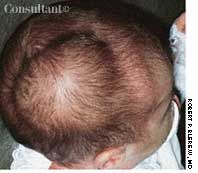Cephalhematoma
A right parietal cephalhematoma was first noted on this 2-week-old girl 2 days after her birth.

A right parietal cephalhematoma was first noted on this 2-week-old girl 2 days after her birth. Caused by bleeding under the outer periosteum of a newborn's skull bone, usually the parietal bone, swelling becomes evident by day 2 or 3 after delivery. The swelling is confined to the involved bone and does not extend beyond the suture lines or the midline of the skull.
A cephalhematoma is believed to occur from the compression or shearing forces exerted on the head as it descends through the birth canal. Underlying skull fractures are present in up to 25% of neonates with this condition. All resolve completely and spontaneously without sequelae, usually by 6 to 8 weeks of age.
Treatment with needle aspiration is contraindicated because of the possibility of introducing an infection. The major differential diagnosis is caput succedaneum (edema of the presenting part of the scalp), which, unlike a cephalhematoma, is present at birth and may extend beyond the suture lines or midline of the skull.